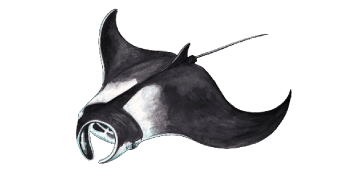
Manta ray
(Manta birostris)
In the 18th and 19th centuries all sorts of horror stories circulated among sailors about manta rays, that were referred to as ‘devilfish’ at the time probably due to their appearance and size.
At the time, they were thought to be dangerous but, today, we know that they are harmless, gentle giants. They are popular with divers and most individuals tolerate the proximity of humans.
Unlike other ray species, they have no poisonous barb on their tail. Manta rays usually remain in the upper layers of the water column, where they can feed on their prey but apparently rest close to the sea floor.
General information
Further names: Portuguese: Manta
Size of adults: Five to eight metres long; width of up to 7 metres.
Prey: Mainly plankton but also small fish.
Life cycle and behaviour: These animals reach sexual maturity at an age of approx. 5 years. Females give birth to live young which develop in the female’s oviduct (similar to the Fallopian tubes in humans) from fertilised eggs that hatch while still in the mother’s body. This means that mantas belong to the group of viviparous fish. They have a gestation period of about 13 months, and juveniles are already 1.5 metres wide upon birth and weigh 10 kg.
Habitat and range: Mantas are found world-wide in tropical and temperate oceans, with their northernmost place of occurrence being the Azores, the southernmost South-Africa and New Zealand. They usually prefer coastal waters close to reefs or cliffs, upwelling zones (coastal areas where water from the deep rich in nutrients rises to the surface) and oceanic archipelagos.
Distinctive features: Dark grey back; pale to white belly; very broad head with long cephalic fins (“head-fins”) on both sides which they use to channel water rich in planktons into their mouth at the front tip of the body (also called a ‘terminal mouth’). They sometimes breach, which may be a part of their courtship display. Manta rays beat with their long fins much like birds and glide elegantly through the water. There are almost always remora fish (ectoparasites) attached to their skin which cause no harm to the host.
Taxonomy: Class: Chondrichthyes (Cartilaginous fish); Family: Myliobatidae (Eagle rays); Genus: Manta
Threats/population size: Manta rays are often caught in fishing nets (drift nets and gill nets; tuna fishing) and are even hunted in some countries. Their meat is considered a local delicacy, their liver is rich in oil and their skin is processed into sanding materials. Due to their slow reproduction rate and being hunted in parts of their range, populations of manta ray species are considered vulnerable. A further problem is the now widespread pollution of coastal waters.
